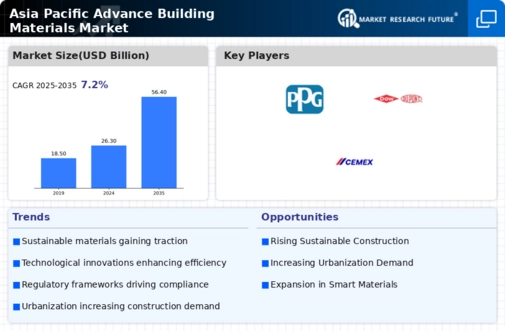. Related Reports LIST OF TABLES TABLE 1 ASIA PACIFIC ADVANCE BUILDING MATERIALS MARKET, SYNOPSIS, 2025 - 2034 TABLE 2 ASIA PACIFIC ADVANCE BUILDING MATERIALS MARKET, ESTIMATES & FORECAST, 2025 - 2034 (USD BILLION) TABLE 3 ASIA PACIFIC ADVANCE BUILDING MATERIALS MARKET, BY APPLICATION, 2025 - 2034 (USD BILLION) TABLE 4 ASIA PACIFIC ADVANCE BUILDING MATERIALS MARKET, BY TYPE, 2025 - 2034 (USD BILLION) TABLE 5 ASIA PACIFIC ADVANCE BUILDING MATERIALS MARKET, BY MATERIAL, 2025 - 2034 (USD BILLION) TABLE 6 CHINA ADVANCE BUILDING MATERIALS MARKET, BY APPLICATION, 2025 - 2034 (USD BILLION) TABLE 7 CHINA ADVANCE BUILDING MATERIALS MARKET, BY TYPE, 2025 - 2034 (USD BILLION) TABLE 8 CHINA ADVANCE BUILDING MATERIALS MARKET, BY MATERIAL, 2025 - 2034 (USD BILLION) TABLE 9 JAPAN ADVANCE BUILDING MATERIALS MARKET, BY APPLICATION, 2025 - 2034 (USD BILLION) TABLE 10 JAPAN ADVANCE BUILDING MATERIALS MARKET, BY TYPE, 2025 - 2034 (USD BILLION) TABLE 11 JAPAN ADVANCE BUILDING MATERIALS MARKET, BY MATERIAL, 2025 - 2034 (USD BILLION) TABLE 12 INDIA ADVANCE BUILDING MATERIALS MARKET, BY APPLICATION, 2025 - 2034 (USD BILLION) TABLE 13 INDIA ADVANCE BUILDING MATERIALS MARKET, BY TYPE, 2025 - 2034 (USD BILLION) TABLE 14 INDIA ADVANCE BUILDING MATERIALS MARKET, BY MATERIAL, 2025 - 2034 (USD BILLION) TABLE 15 AUSTRALIA ADVANCE BUILDING MATERIALS MARKET, BY APPLICATION, 2025 - 2034 (USD BILLION) TABLE 16 AUSTRALIA ADVANCE BUILDING MATERIALS MARKET, BY TYPE, 2025 - 2034 (USD BILLION) TABLE 17 AUSTRALIA ADVANCE BUILDING MATERIALS MARKET, BY MATERIAL, 2025 - 2034 (USD BILLION) TABLE 18 SOUTH KOREA ADVANCE BUILDING MATERIALS MARKET, BY APPLICATION, 2025 - 2034 (USD BILLION) TABLE 19 SOUTH KOREA ADVANCE BUILDING MATERIALS MARKET, BY TYPE, 2025 - 2034 (USD BILLION) TABLE 20 SOUTH KOREA ADVANCE BUILDING MATERIALS MARKET, BY MATERIAL, 2025 - 2034 (USD BILLION) TABLE 21 INDONESIA ADVANCE BUILDING MATERIALS MARKET, BY APPLICATION, 2025 - 2034 (USD BILLION) TABLE 22 INDONESIA ADVANCE BUILDING MATERIALS MARKET, BY TYPE, 2025 - 2034 (USD BILLION) TABLE 23 INDONESIA ADVANCE BUILDING MATERIALS MARKET, BY MATERIAL, 2025 - 2034 (USD BILLION) TABLE 24 THAILAND ADVANCE BUILDING MATERIALS MARKET, BY APPLICATION, 2025 - 2034 (USD BILLION) TABLE 25 THAILAND ADVANCE BUILDING MATERIALS MARKET, BY TYPE, 2025 - 2034 (USD BILLION) TABLE 26 THAILAND ADVANCE BUILDING MATERIALS MARKET, BY MATERIAL, 2025 - 2034 (USD BILLION) TABLE 27 VIETNAM ADVANCE BUILDING MATERIALS MARKET, BY APPLICATION, 2025 - 2034 (USD BILLION) TABLE 28 VIETNAM ADVANCE BUILDING MATERIALS MARKET, BY TYPE, 2025 - 2034 (USD BILLION) TABLE 29 VIETNAM ADVANCE BUILDING MATERIALS MARKET, BY MATERIAL, 2025 - 2034 (USD BILLION) TABLE 30 MALAYSIA ADVANCE BUILDING MATERIALS MARKET, BY APPLICATION, 2025 - 2034 (USD BILLION) TABLE 31 MALAYSIA ADVANCE BUILDING MATERIALS MARKET, BY TYPE, 2025 - 2034 (USD BILLION) TABLE 32 MALAYSIA ADVANCE BUILDING MATERIALS MARKET, BY MATERIAL, 2025 - 2034 (USD BILLION) TABLE 33 SINGAPORE ADVANCE BUILDING MATERIALS MARKET, BY APPLICATION, 2025 - 2034 (USD BILLION) TABLE 34 SINGAPORE ADVANCE BUILDING MATERIALS MARKET, BY TYPE, 2025 - 2034 (USD BILLION) TABLE 35 SINGAPORE ADVANCE BUILDING MATERIALS MARKET, BY MATERIAL, 2025 - 2034 (USD BILLION) TABLE 36 REST OF ASIA PACIFIC ADVANCE BUILDING MATERIALS MARKET, BY APPLICATION, 2025 - 2034 (USD BILLION) TABLE 37 REST OF ASIA PACIFIC ADVANCE BUILDING MATERIALS MARKET, BY TYPE, 2025 - 2034 (USD BILLION) TABLE 38 REST OF ASIA PACIFIC ADVANCE BUILDING MATERIALS MARKET, BY MATERIAL, 2025 - 2034 (USD BILLION) LIST OF FIGURES FIGURE 1 RESEARCH PROCESS FIGURE 2 MARKET STRUCTURE FOR THE ASIA PACIFIC ADVANCE BUILDING MATERIALS MARKET FIGURE 3 MARKET DYNAMICS FOR THE ASIA PACIFIC ADVANCE BUILDING MATERIALS MARKET FIGURE 4 ASIA PACIFIC ADVANCE BUILDING MATERIALS MARKET, SHARE (%), BY APPLICATION, 2022 FIGURE 5 ASIA PACIFIC ADVANCE BUILDING MATERIALS MARKET, SHARE (%), BY TYPE, 2022 FIGURE 6 ASIA PACIFIC ADVANCE BUILDING MATERIALS MARKET, SHARE (%), BY MATERIAL, 2022 FIGURE 7 ASIA PACIFIC ADVANCE BUILDING MATERIALS MARKET, SHARE (%), BY REGION, 2022 FIGURE 8 ASIA PACIFIC ADVANCE BUILDING MATERIALS MARKET: COMPANY SHARE ANALYSIS, 2022 (%) FIGURE 9 OERLIKON BALZERS COATING INDIA LIMITED: FINANCIAL OVERVIEW SNAPSHOT FIGURE 10 OERLIKON BALZERS COATING INDIA LIMITED: SWOT ANALYSIS FIGURE 11 PPG INDUSTRIES INC.: FINANCIAL OVERVIEW SNAPSHOT FIGURE 12 PPG INDUSTRIES INC.: SWOT ANALYSIS FIGURE 13 SAINT-GOBAIN GROUP: FINANCIAL OVERVIEW SNAPSHOT FIGURE 14 SAINT-GOBAIN GROUP: SWOT ANALYSIS FIGURE 15 SHERWIN-WILLIAMS COMPANY: FINANCIAL OVERVIEW SNAPSHOT FIGURE 16 SHERWIN-WILLIAMS COMPANY: SWOT ANALYSIS FIGURE 17 APV ENGINEERED COATINGS INC: FINANCIAL OVERVIEW SNAPSHOT FIGURE 18 APV ENGINEERED COATINGS INC: SWOT ANALYSIS FIGURE 19 BASF SE: FINANCIAL OVERVIEW SNAPSHOT FIGURE 20 BASF SE: SWOT ANALYSIS FIGURE 21 KINGSPAN GROUP PLC: FINANCIAL OVERVIEW SNAPSHOT FIGURE 22 KINGSPAN GROUP PLC: SWOT ANALYSIS FIGURE 23 DOWDUPONT INC.: FINANCIAL OVERVIEW SNAPSHOT FIGURE 24 DOWDUPONT INC.: SWOT ANALYSIS FIGURE 25 CEMEX: FINANCIAL OVERVIEW SNAPSHOT FIGURE 26 CEMEX: SWOT ANALYSIS FIGURE 27 KNAUF GIPS KG: FINANCIAL OVERVIEW SNAPSHOT FIGURE 28 KNAUF GIPS KG: SWOT ANALYSIS



 Source: Secondary Research, Primary Research, Market Research Future Database and Analyst Review
Source: Secondary Research, Primary Research, Market Research Future Database and Analyst Review



Leave a Comment